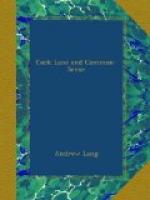Over classical tales we need not linger. Pliny, Plutarch, Suetonius, St. Augustine, Lucian, Plautus (in the Mostellaria), describe, with more or less of seriousness, the apparitions and noises which haunted houses, public baths, and other places. Occasionally a slain man’s phantom was anxious that his body should be buried, and the reported phenomena were akin to those in modern popular legends. Sometimes, in the middle ages, and later, the law took cognisance of haunted houses, when the tenant wished to break his lease. A collection of authorities is given elsewhere, in Ghosts before the Law. It is to be noticed that Bouchel, in his Bibliotheque du Droit Francais, chiefly cites classical, not modern, instances.
Among the most careful and exhaustive post-mediaeval writers on haunted houses we must cite Petrus Thyraeus of the Society of Jesus, Doctor in Theology. His work, published at Cologne in 1598, is a quarto of 352 pages, entitled, ’Loca Infesta; That is, Concerning Places Haunted by Mischievous Spirits of Demons and of the Dead. Thereto is added a Tract on Nocturnal Disturbances, which are wont to bode the deaths of Men.’ Thyraeus begins, ’That certain places are haunted by spectres and spirits, is no matter of doubt,’ wherein a modern reader cannot confidently follow him.
When it comes to establishing his position Thyraeus most provokingly says, ‘we omit cases which are recent and of daily occurrence,’ such as he heard narrated, during his travels, in ’a certain haunted castle’. A modern inquirer naturally prefers recent examples, which may be inquired into, but the old scholars reposed more confidence in what was written by respected authors, the more ancient the more authoritative. However Thyraeus relies on the anthropological test of evidence, and thinks that his belief is confirmed by the coincident reports of hauntings, ’variis distinctissimisque locis et temporibus,’ in the most various times and places. There is something to be said for this view, and the identity of the alleged phenomena, in all lands and ages, does raise a presumption in favour of some kind of abnormal occurrences, or of a common species of hallucinations. Like most of the old authors Thyraeus quotes Augustine’s tale of a haunted house, and an exorcism in De Civitate Dei (lib. xxii. ch. viii.). St. Gregory has also a story of one Paschasius, a deacon, who haunted some baths, and was seen by a bishop. {131a} There is a ghost who rode horses, and frightened the religious in the Life of Gregory by Joannes Diaconus (iv. 89). In the Life of Theodorus one Georgius, a disciple of his, mentions a house haunted by stone-throwing sprites, a very common phenomenon in the books of Glanvill, and Increase Mather, in witch trials, and in rural disturbances. Omitting other examples Cardan {131b} is cited for a house at Parma, in which during a hundred years the phantom of an old woman was seen before the death of members of the family.




